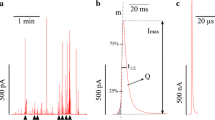Abstract
To differentiate whether the primary volume signal in dog red cells arises from a change in cell configuration or the concentration and dilution of cell contents, we prepared resealed ghosts that had the same surface area and hemoglobin concentration as intact cells but less than 1/3 their volume. Shrinkage of both intact cells and resealed ghosts triggered Na/H exchange. Activation of this transporter in the two preparations correlated closely with cytosolic protein concentration but not at all with volume. The Na/H exchanger was more sensitive to shrinkage in albumin-loaded resealed ghosts than in intact cells or ghosts containing only hemoglobin. Similar results were obtained for the swelling-induced [K-Cl] cotransporter. We believe perception of cell volume originates with changes in cytoplasmic protein concentration. We think the kinases and phosphatases that control the activation of membrane transporters in response to cell swelling or shrinkage are regulated by the mechanism of macromolecular crowding.
Similar content being viewed by others
References
Cossins AR: A sense of cell size. Nature 352: 667, 1991
Minton AP: The effect of volume occupancy upon the thermodynamic activity of proteins: some biochemical consequences. Mol Cell Biochem 55: 119–140, 1983
Minton AP: Holobiochemistry: The effect of local environment upon the equilibria and rates of biochemical reactions. Int J Biochem 22: 1063–1067, 1990
Jarvis TC, Ring DM, Daube SS, von Hippel PH: ‘Macromolecular crowding’: thermodynamic consequences for protein-protein interactions within the T4 DNA replication complex. J Biol Chem 265: 15160–15167, 1990
Adair GS: A theory of partial osmotic pressures and membrane equilibria with special reference to the application of Dalton's law to haemoglobin solutions in the presence of salts. Proc Roy Soc London Sct A 120: 573–603, 1928
Eaton WA, Hofrichter J: Sickle cell hemoglobin polymerization. Adv Protein Chem 40: 63–279, 1990
Srere PA, Mattheuws CK: Purification of multienzyme complexes. Methods Enzymol 182: 539–551, 1990
Zimmerman SB, Harrison B: Macromolecular crowding increases binding of DNA polymerase to DNA: an adaptive effect. Proc Nat Acad Sci 84: 1871–1875, 1987
Zimmerman SB, Trach SO: Effects of macromolecular crowding on the association of E. coli ribosomal particles. Nucleic Acids Res 16: 6309–6326, 1988
Zimmerman SB, Trach SO: Macromolecular crowding extends the range of conditions under which DNA polymerase is functional. Biochim Biophys Acta 949: 297–304, 1988
Shearwin KE, Winzor DJ: Thermodynamic nonideality in macromolecular solutions. Eur J Biochem 190: 523–529, 1990
Fulton AB: How crowded is the cytoplasm? Cell 30: 345–347, 1982
Sachs F: Baroreceptor mechanisms at the cellular level. Federation Proc 46: 12–16, 1987
Watson PA: Function follows form: generation of intracellular signals by cell deformation. FASEB J 5: 2013–2019, 1991
Sarkadi B, Parker JC: Activation of ion transport pathways by changes in cell volume. Biochimica Biophysica Acta Reviews on Biomembranes 1071: 407–427, 1991
Parker JC, Castranova V: Volume-responsive sodium and proton movements in dog red blood cells. J Gen Physiol 84: 379–401, 1984
Parker JC, McManus TJ, Starke LC, Gitelman HJ: Coordinated regulation of Na/H exchange and [K-Cl] cotransport in dog red cells. J Gen Physiol 96: 1141–1152, 1990
Colclasure GC, Parker JC: Cytosolic protein concentration is the primary volume signal in dog red cells. J Gen Physiol 98: 881–892, 1991
Hoffman JF: Physiological characteristics of human red blood cell ghosts. Journal of General Physiology 42: 9–28, 1958
Wood PG, Passow H: Techniques for the modification of the intracellular composition of red blood cells. In Techniques in Cellular Physiology (ed, Baker, P.F.) vol Pl/1(112), Elsevier/ North Holland, County Clare Ireland, pp 1–43, 1981
Colclasure GC, Parker JC: Regulation of the [K-Cl] cotransporter in resealed ghosts from dog red cells. J Gen Physiol 98: 18a, 1991
Minton AP, Edelhoch H: Light scattering of bovine serum albumin solutions: extension of the hard particle model to allow for electrostatic repulsion. Biopolymers 21: 451–458, 1982
Author information
Authors and Affiliations
Rights and permissions
About this article
Cite this article
Parker, J.C., Craig Colclasure, G. Macromolecular crowding and volume perception in dog red cells. Mol Cell Biochem 114, 9–11 (1992). https://doi.org/10.1007/BF00240291
Issue Date:
DOI: https://doi.org/10.1007/BF00240291




